
On World Environment Day, NGOs point to alleged violation of guidelines at DMC waste disposal site
DIMAPUR, JUNE 5 (MExN): A team of NGOs including the Human Rights Law Network, Pro Rural and CanYouth today alleged that “major guidelines or conditions” requisite to run waste dumping sites is not being adhered to at the Dimapur Municipal Garbage/Waste dumping site at United North Block area.
A joint statement from ID Gil, Human Rights Network; Athilu Khrasi, Pro Rural; and Jenpu, CanYouth said this after the organisations had visited the site on June 4.
On inspecting the site, the NGOs stated that bio-medical waste, hazardous waste and non segregated solid wastes are collectively and directly dumped onto the site just as they are brought and burnt, often times, against the explicit rules forbidding it. “There is no treatment of garbage, no segregation. The rest of the wastes are left untreated, uncovered and out in the open,” it revealed.
Further it quoted people from localities as stating that “since last year, the DMC had, 4-5 times, unilaterally and arbitrarily re-extended the shifting from the site against their token promises to the agitators.”
Terming the current waste disposal site as a “paragon of environmental law violation,” it added that the DMC has “miserably and successively failed on all the major fronts.”
Other problems, the NGOs pointed out were the lack of proper retaining wall to contain the garbage spilling over the road; and proximity of around 30 households living right around the dumping field. They stated that the site poses “equal threat” to 5,000 odd households of the locality and beyond in the form of contamination of ground water from decades of toxic-liquid seepage from the site and the dangerous air that emanates from the wastes.
They further informed that there is no specific timing set for garbage dumping. “Residents can smell the burning of plastics and rubbers as early as 2:00am in the morning. The vehicles carrying garbage, as they cross the area, leaves huge amount of dusts in their wake due to pathetic conditions of the road. There are 10-20 garbage carrying vehicles plying on duty every day, so one can only imagine the amount of pollution the carriers themselves are generating and creating nuisance to the residents in the area,” the organisations said.
Meanwhile, the NGOs noted that the dumping ground is breeding ground for “endless supplies of flies and mosquitoes.” They stated that “direct affect” of the dangers are reportedly witnessed in the form of “acute case of liver swelling in an otherwise healthy looking child, asthma and other respiratory problem especially in the older people, and many cases of water borne disease such as skin disease, diarrhoea, typhoid etc.”
They reminded that Nagaland State comes under the purview of Municipal Solid wastes (Management & Handling) Rules, 2000 which provides specific and mandatory guidelines with regard to site selection for proposed landfill, facilities required at landfill site, specification for landfilling, pollution prevention, water quality monitoring, ambient air quality monitoring, plantation at landfill site, closure of landfill site/post closure, etc.
These specific provisions are to be implemented as per the rules and need to be ensured starting from the planning and design stage. The adequacy and performance of these provisions are to be monitored by the regulating authorities (State Pollution Control Board) during issue of authorization and in regular intervals thereafter.
Further, site selection is to be done based on examination of environmental issues, and the landfill site be planned and designed with proper documentation of a phased construction plan as well as a closure plan, and nearby a waste processing plant or an integral part of it. The proposed landfill site should be away from habitation clusters, forest areas, water bodies, monuments, national parks, wetlands and places of important cultural, historical or religious interest.
The rules also call for monitoring of ground water quality, installation of landfill gas control system including gas collection system, and ambient air quality monitoring.
The NGOs said that “against the basic set standards, there was a drastic contrast on the ground and blatant negligence on the part of the relevant authorities since day one of the project.”
The organisations lamented that irrespective of the mechanism that the DMC employs, “they can never rectify the loss to the environment they have caused.” “The Dhansiri River that is just alongside the site, the local residents who had to bear the difficult times cannot afford to see the site continuing at the present site,” they asserted.
They advised that under the mentorship of the State Pollution Control Board, the DMC should relocate the site and install state-of-the-art processing equipments and all other criteria that a landfill site is supposed to have. “Let no citizen for another day go through the life threatening menace” they appealed.




.jpg)

